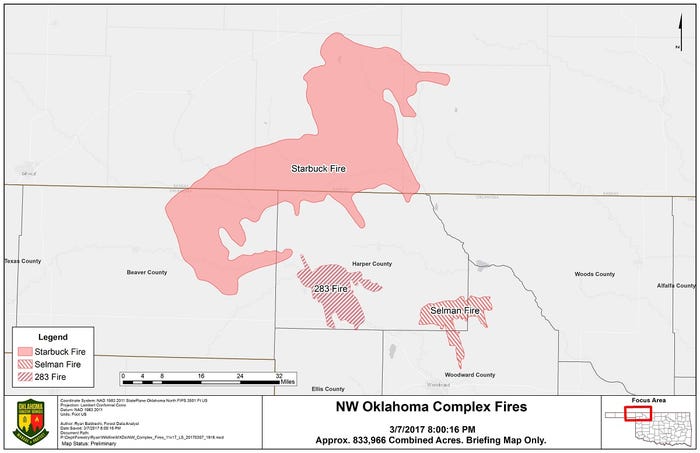
Three separate wildfires are burning, with zero containment reported, on more than 800,000 acres in Northwest Oklahoma, threatening residences, secondary structures, and livestock, according to Suzanne McCombs with the Oklahoma Forestry Service.
News sources also report as many as seven wildfire-related fatalities in Texas, Oklahoma, and Kansas.
“We’re calling this the Northwest Oklahoma Complex Fire,” McCombs told Southwest Farm Press Wednesday. “This complex consists of three separate fires. It is an active situation with zero containment so far. We continue to see extensive damage to livestock and structures.”
McCombs says fire origins are unknown. “The causes are under investigation.”
The Forestry Service webpage http://bit.ly/2mmNehn daily update indicates “significant growth in all fires in the complex.”
The largest of the three fires, in Beaver and Harper counties, covers 715,484 acres in Oklahoma and Kansas. The fire is near Buffalo, Knowles, Gate, Rosston, and Laverne communities in Oklahoma. “Numerous residences, secondary structures, livestock and other infrastructure have been lost,” according to the daily briefing. Reports indicate “zero percent containment. Numerous communities remain threatened. Fire growth continued yesterday and through the nighttime hours.”
Another fire is burning 47,289 acres, approximately 10 miles north of Woodward. Containment is estimated at zero percent. “No estimate (is available) on residences or secondary structures lost. Damage assessments are on-going. Numerous residences remain threatened, and fire growth continued yesterday and through the nighttime hours.”
A fire in Harper County burning near the Rosston, Laverne, and May communities covers 71,168 acres, and is also zero- percent contained. So far, no estimate is available on residences or secondary structures lost; damage assessments are on-going. “Numerous communities remain threatened.” As with the other two fires, the report indicates fire growth continued yesterday and through the night.
The Forestry Service website warns that extreme fire danger exists across a large part of Oklahoma. “Very poor humidity recovery in fine fuels will allow for early fire starts today. Relative humidity is expected to fall into the upper single digits to low teens across the majority of the state today. Southerly winds from 15 to 20 mph with gusts near and above 30 mph are forecast. Temperatures this afternoon are expected to reach into the 70 degree range. The current forecast calls for the highest wind gusts to be east of Interstate 35 and north of US 412. Expect any fire that starts today to burn very intensely with rapid rates of spread.”
Reports from the Texas Panhandle http://bit.ly/2mk2qtZ indicate more than 440,000 acres of land has been burned across eight counties. Livestock, structure and fence loss has been extensive.
Texas A&M AgriLife Extension Service specialists say accurate estimates on livestock losses may not be available for weeks. With fences destroyed, cattle will wander looking for water and to escape danger.

Oklahoma wildfire map
About the Author(s)
You May Also Like






